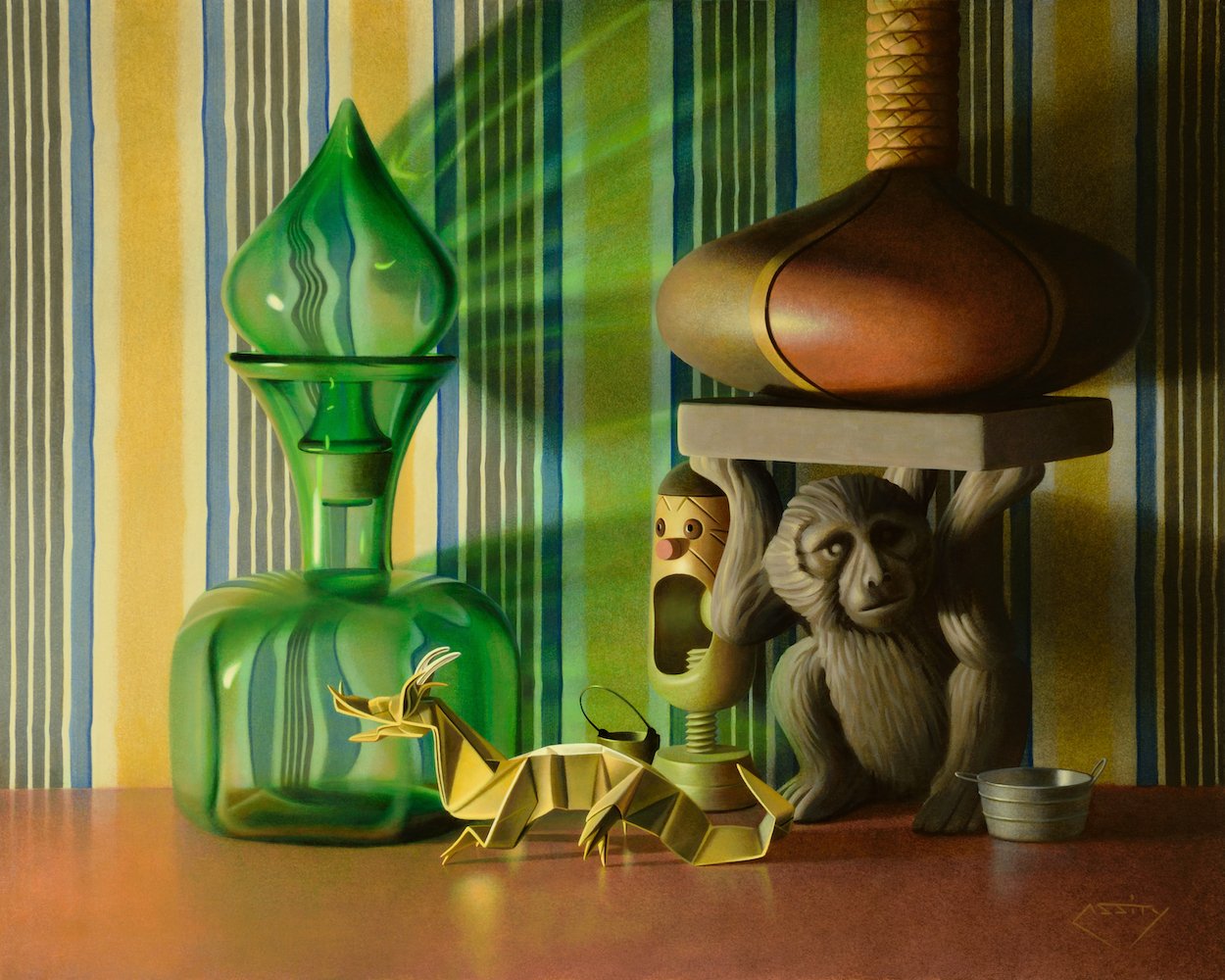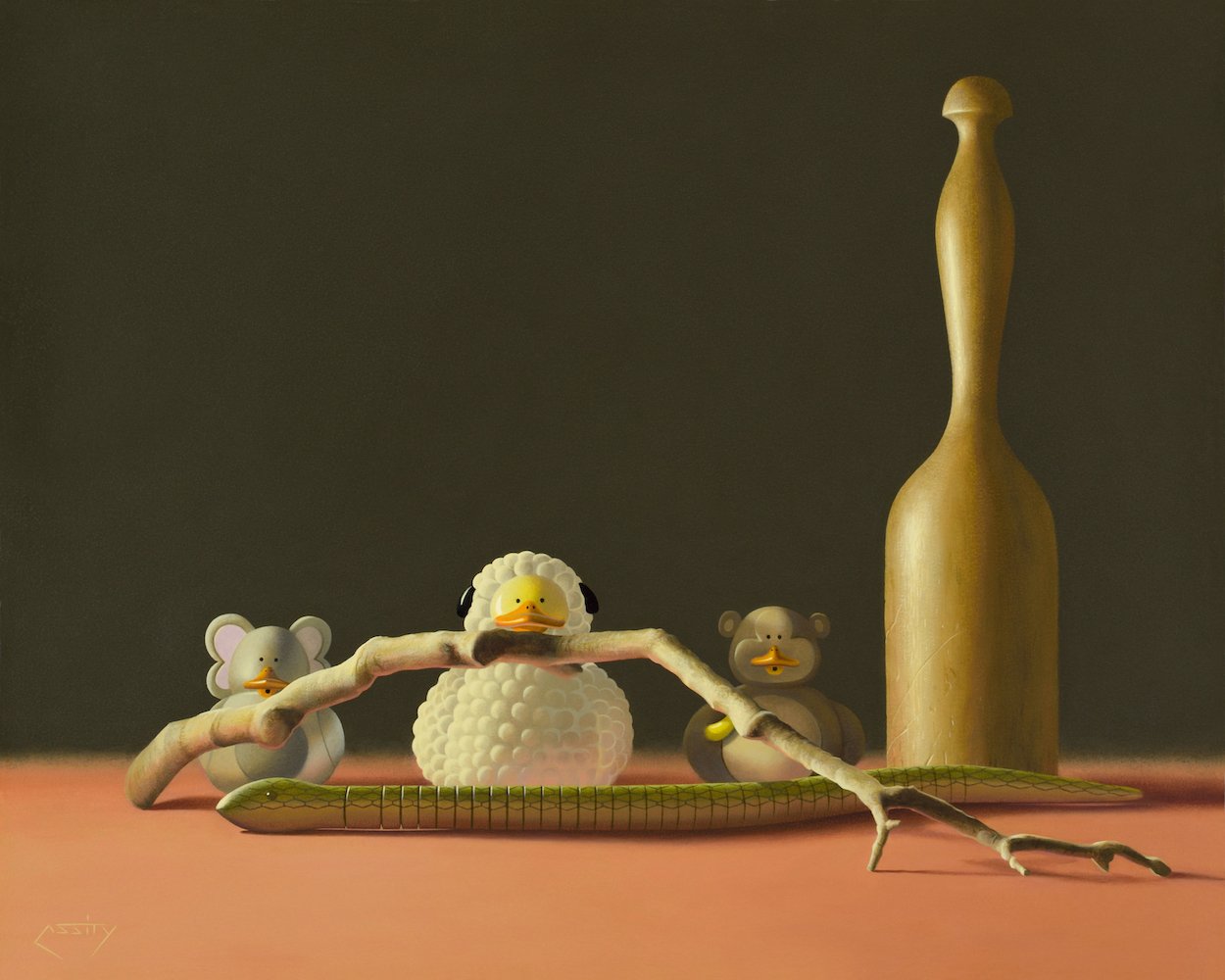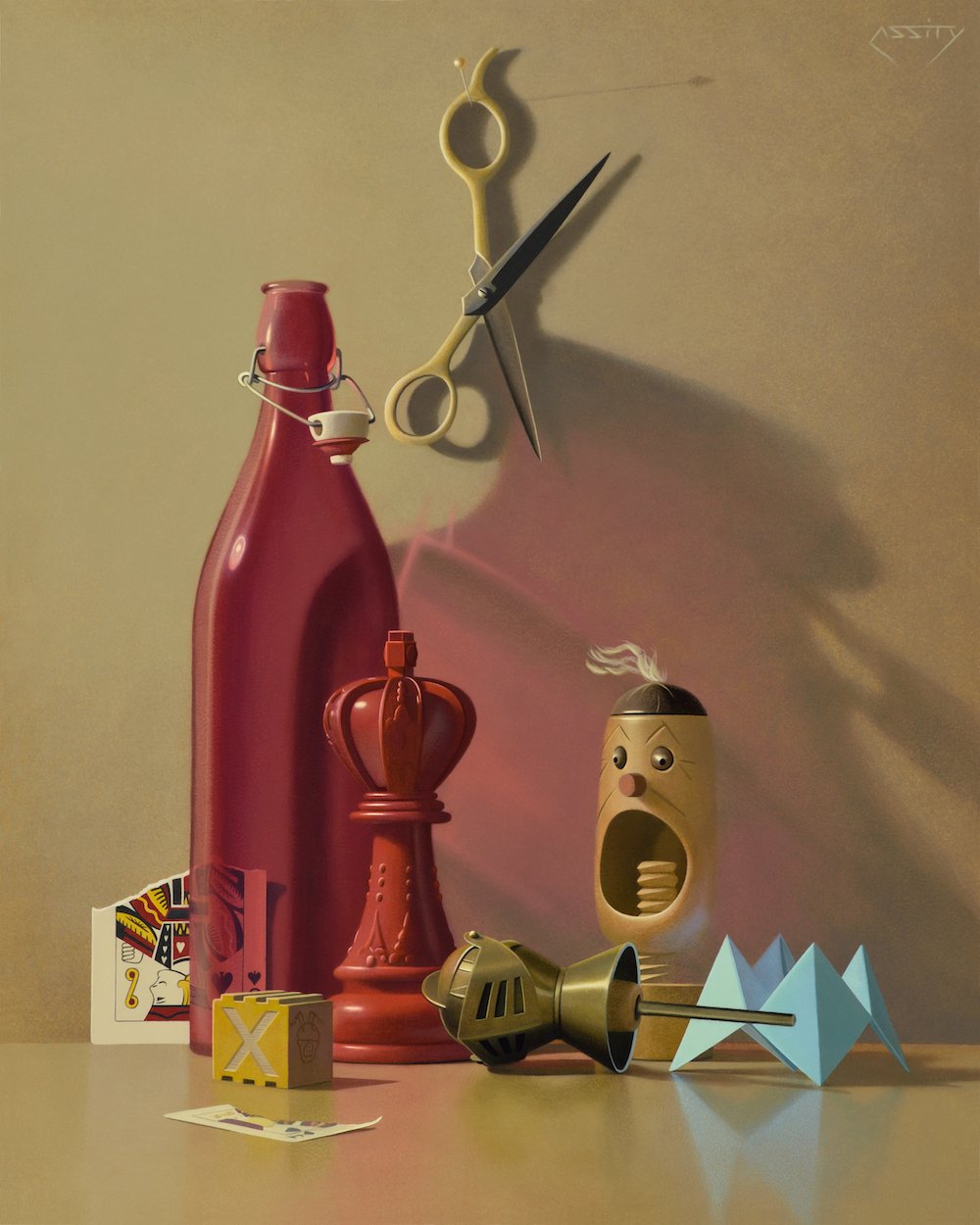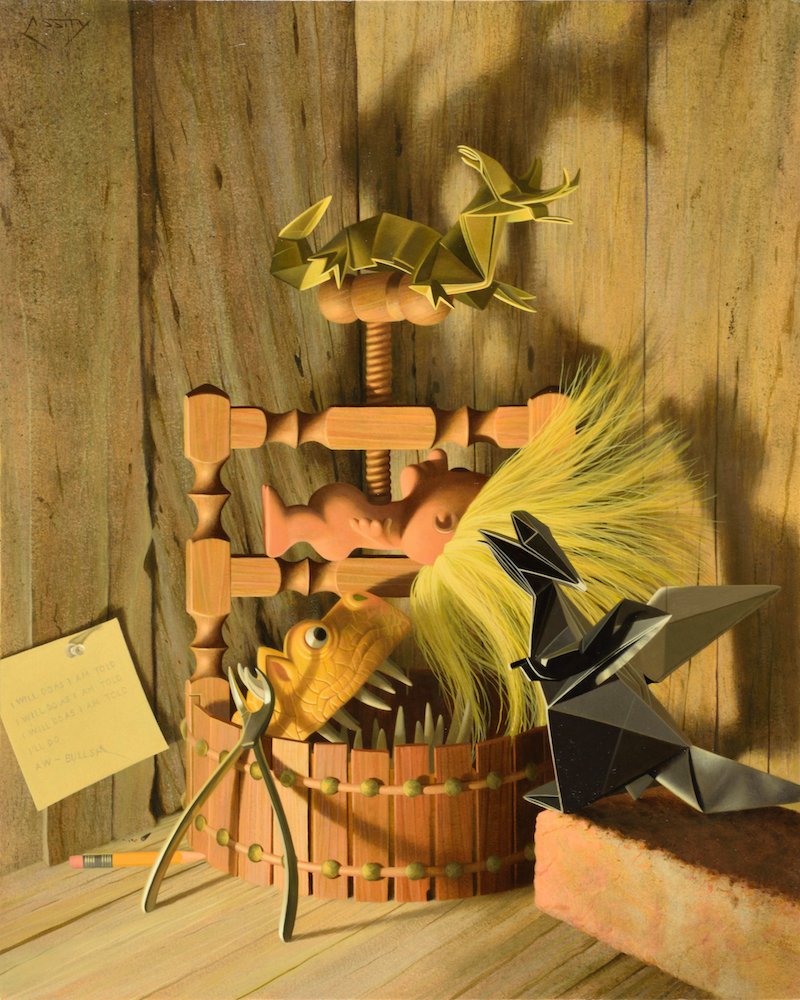Interview with artist Daniel Mark Cassity
Daniel Mark Cassity is a still life painter living in Hot Springs. His extraordinary oil paintings are vignettes depicting stories within his imaginary world. His work has been in exhibitions of the Oil Painters of America, the International Guild of Realism and the Annual Delta Exhibition, and featured in a number of literary and art magazines. More of Daniel’s work can be found at his website danielmarkcassity.com.
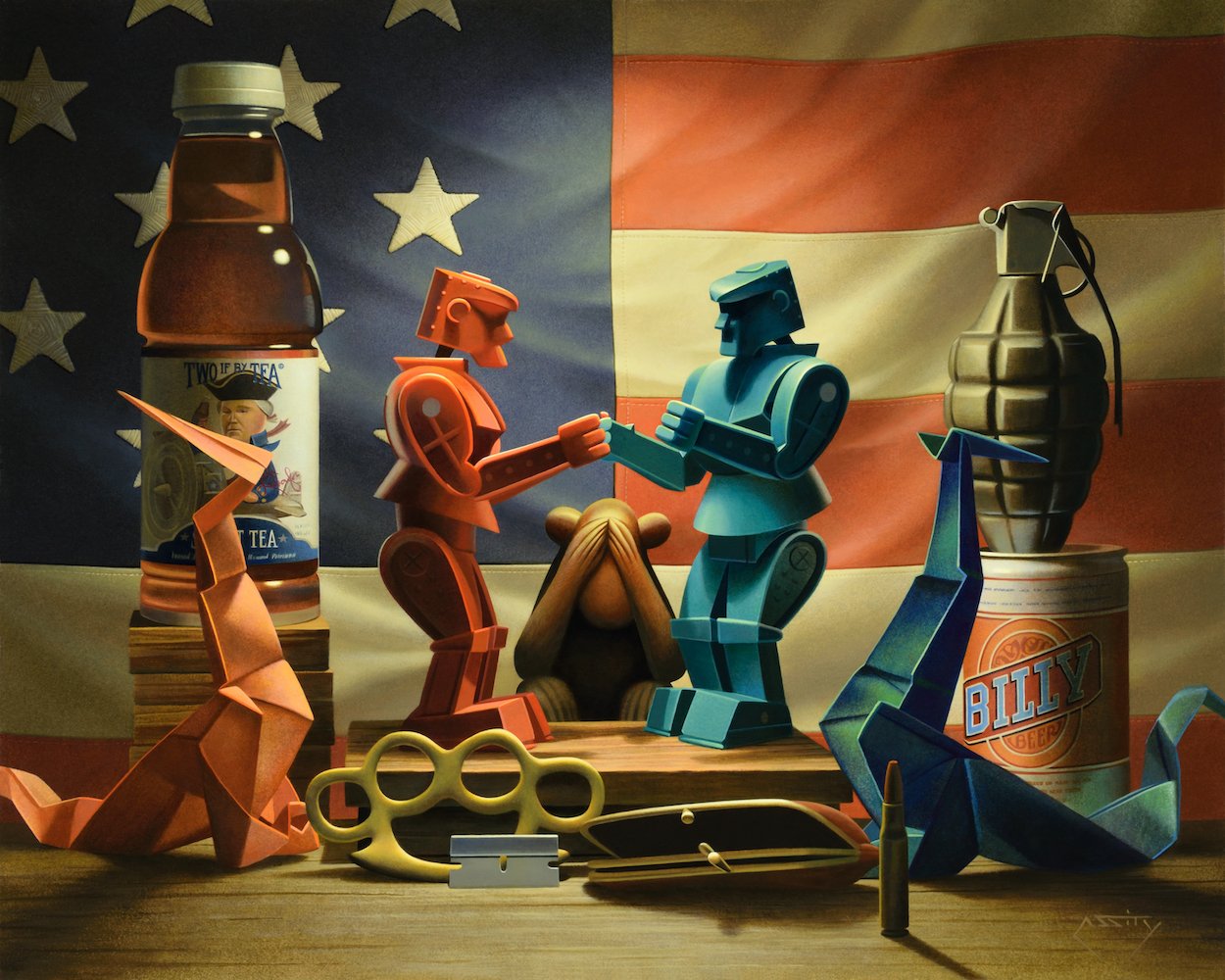
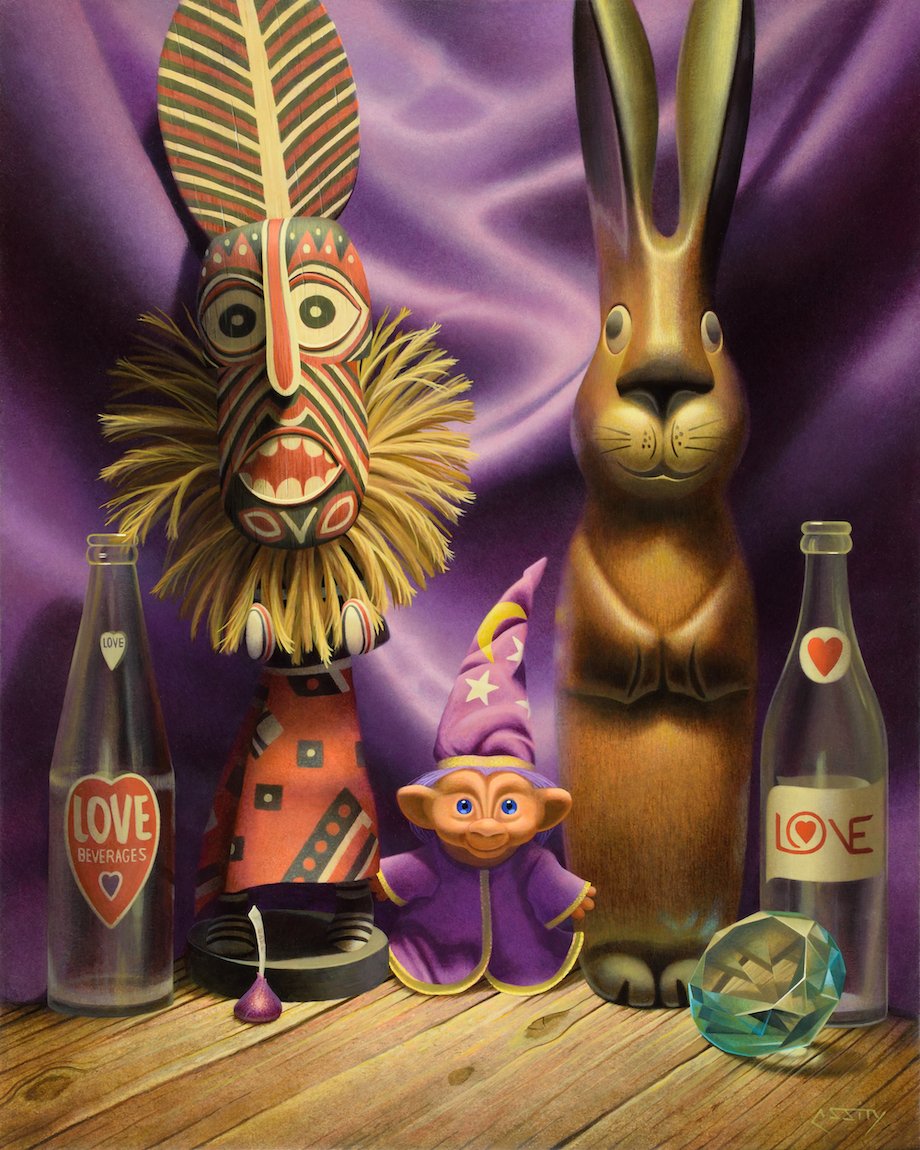
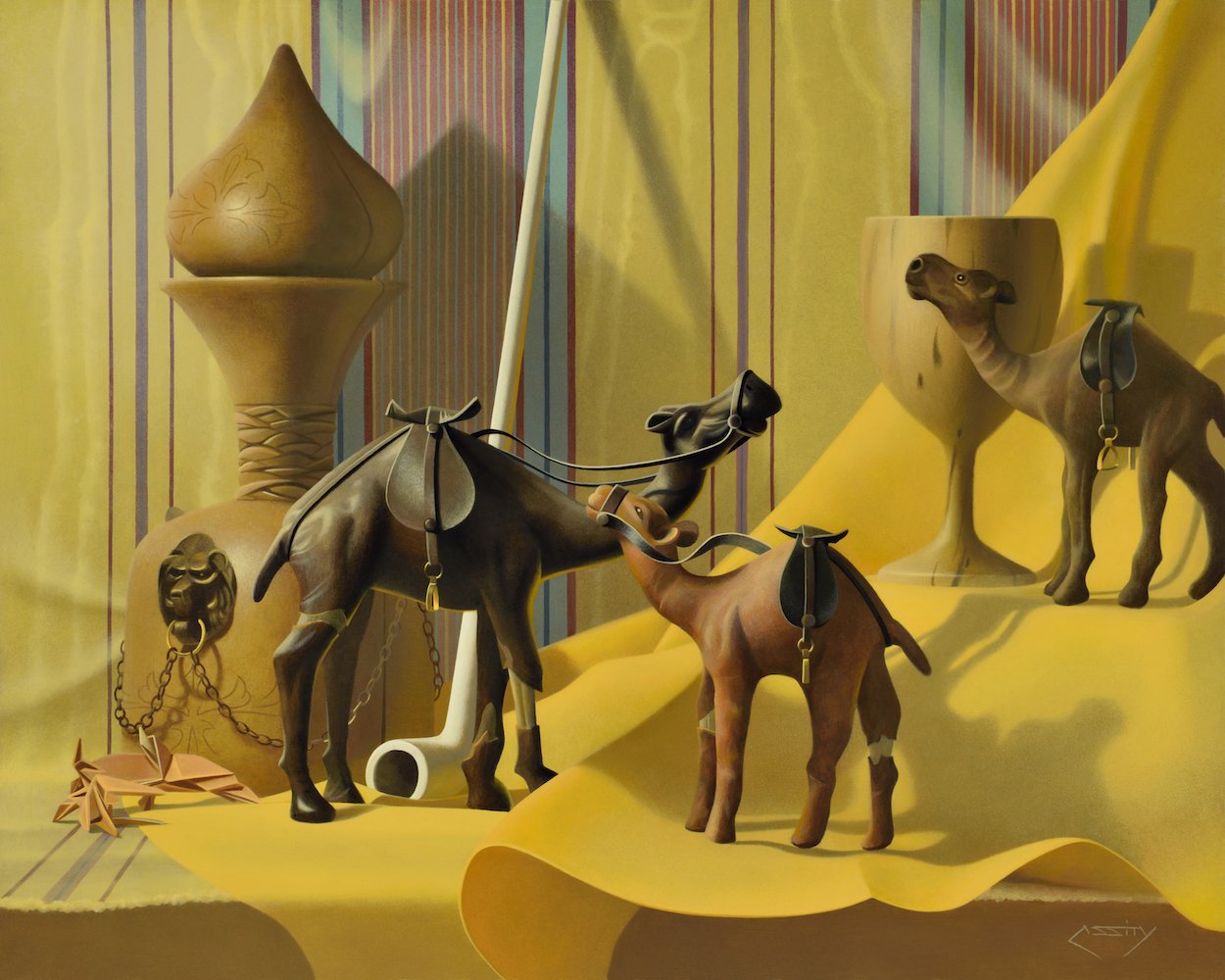
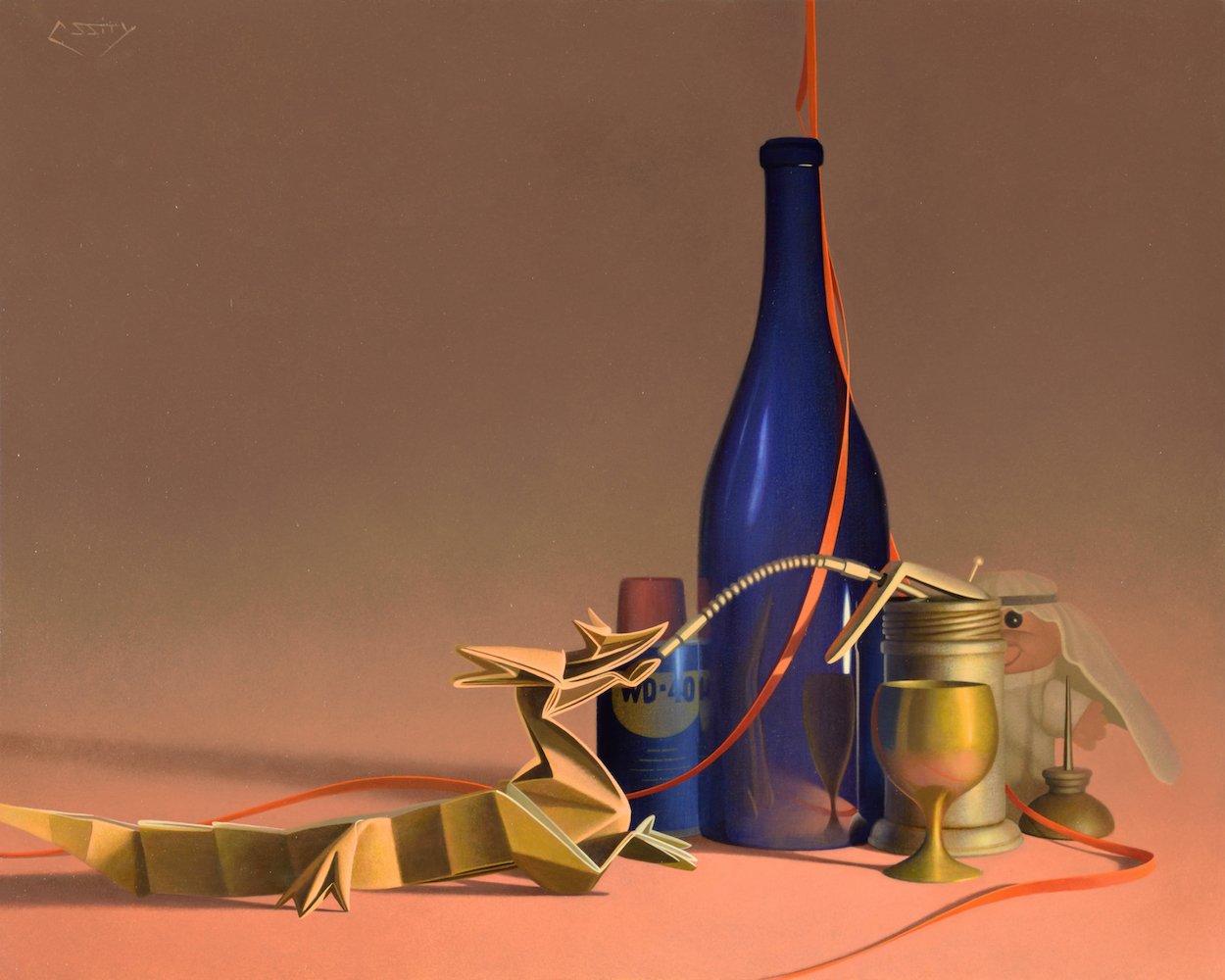
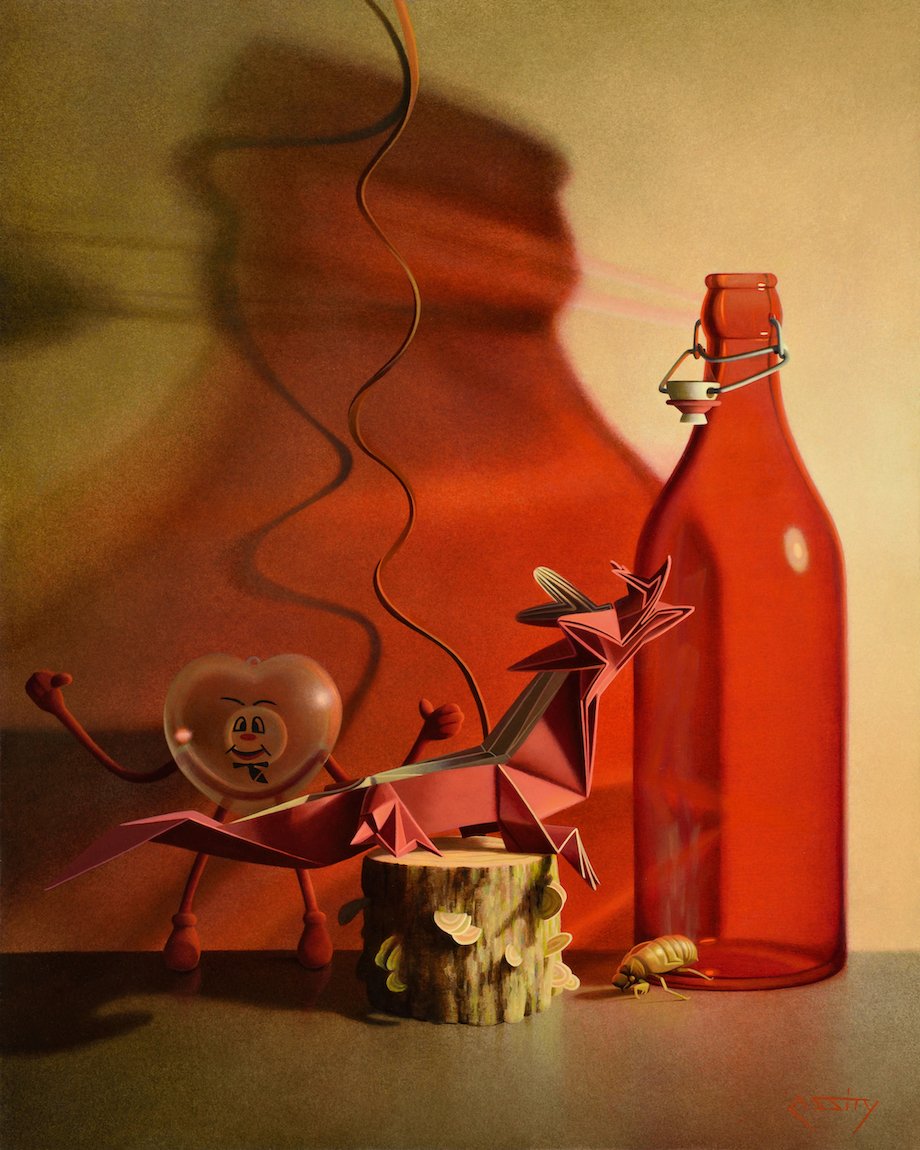
AAS: Daniel, tell be about your background. Where did you grow up?
DC: I grew up in the small town of Bastrop, Louisiana, where I spent a lot of time outdoors. My father worked for International Paper, which prompted us to move from Bastrop to Mansfield, Louisiana mid-way through my tenth grade. I finished high school in Mansfield, and then went to Ruston, to attend Louisiana Tech University. I graduated LTU in 1988 with a painting BFA, and then travelled to Greenville, North Carolina to pursue a master’s degree at East Carolina University. I thought I might be headed toward a professorship somewhere, requiring a master’s, but for some reason I changed my mind and left the graduate program about halfway through. By that time, I had grown so fond of North Carolina that I stayed there twenty years. In 2009 I returned to Louisiana, where I soon crossed paths with Diana Garrison from my LTU days. She is an artist, and art teacher, and was taking a teaching job that required her to reside in Arkansas, so we moved to Hot Springs, and married there. We currently have three cats. I’m dyslexic, and useless at math.
AAS: What was your exposure to art like growing up?
DC: I am a maker at heart, so I was making stuff from my earliest years – it didn’t seem to matter what, just something. I would sit alone, playing with modelling clay, construction paper, or drawing. I can remember a modelling clay Frankenstein (guts included) in a construction paper graveyard. I had fabricated a scene, just as I do now when setting up a still life. I think it is crucial for me to stay directly in touch with eight-year-old Daniel – as that is my core as an artist – and work from that same beautiful mysterious compulsion. It’s personally profound, for in the rare instances that I’ve been without that compulsion, I was dead inside.
As to training, I took private lessons from Anne Goss Nelson in my early teens in Bastrop. She taught “paint what you see” and fundamentals. I was only later introduced to abstraction at LTU where I worked most closely with Douglas Walton, Peter Jones, and Ed Pinkston. One year the art department took a field trip to Fort Worth to see a traveling exhibition of the Courtauld Collection. That was an incredible experience for me as a young painter. My LTU days were exciting exploratory times.
AAS: You are a still life painter sort of in the style of Dutch Realism from the 17th century. But what I love about your work is that it is realism with a modern twist. It is still about composition and lighting and technique but with humor and storytelling.
“I have become an ambassador for still life painting, so it is important to me that I demonstrate that the genre is fertile and thriving.”
DC: I am classically trained, with a total of 7 years in academia. However, I must point out that the particular techniques I utilize were developed over time in isolation. I’ve since learned that Maxfield Parrish used some of the same techniques, as well as some old masters, but I arrived at the techniques on my own, in studio. These techniques, utilizing stipple brushes, eliminate brush strokes and result in a sort of orange peel surface. Once it becomes familiar, my surface, subject matter aside, is easily recognizable. It is my particular approach to realist painting, I guess. The process is demanding, slow and painstaking, without instant gratification. I give all I have to it.
I have become an ambassador for still life painting, so it is important to me that I demonstrate that the genre is fertile and thriving. Viewers will obviously notice my nod to classicism, but at the same time it is important that I stay contemporary and fresh. I guess the notion is that one doesn’t have to abandon the past to move into the future. The Kingdom has served me well, as I am appreciated in traditional, as well as very modern circles.
I’m fond of all the expected greats, from Caravaggio, to Hans Hoffman, to present. I’m constantly delighted and challenged by contemporary painters. I have noted, perhaps because I settled in Arkansas, that I share creative similarities with Donald Roller Wilson, as he is a visual storyteller exploring his imaginary world.
AAS: The first time I saw your work was at the 59th Annual Delta Exhibition in 2017. I was mesmerized by The Wonderweapon and it received an Honorable Mention Award.
DC: The Wonderweapon is an example of a heavy subject presented with absurdity. The premise is that this monstrosity is being presented for sale to the King, with the sales pitch that it will be so decisively fearsome as to “end all warfare.” There are many historical examples of just such thoughts: the Gatling gun is one. Of course the result is an arms race.
I built the Wonderweapon for the sole purpose of representing it in paint. After I finished the construction – liking it - I asked myself if I could produce a painting that would outshine the sculpture. I honestly wasn’t sure, but I think I pulled it off. The painting premiered at Little Rock’s 2017 Delta exhibition. I wish I had thought to exhibit the “sculpture” with the painting. I must do that someday. 2017 was my second time to participate in the Delta, and each time I’ve been struck by the presentation and scope of it. I didn’t realize at first that a Delta Honorable Mention has some weight to it. I’ll pursue the Delta again for certain.
The Wonderweapon, 16” x 20”, oil on panel
AAS: I am a big fan of origami and although I have tried, I am terrible at it. Several vignettes from your The Kingdom series feature origami dragons. Tell me about Keeper of the Flame and The Kingdom, Invaded. Did you fold those models or are they just from your imagination?
Keeper of the Flame, 20” x 16”, oil on panel
DC: Origami dragons are my muse, of sorts, or at least are the center-point of The Kingdom. I have quite a stable of them, with a new one on the way. Diana’s son Jonathan folds them for me. I noticed a dragon he had folded around 2011, and instantly knew I would do something with it. It took a bit of time to simmer the idea, but that paper dragon led not only to my use of origami dragons as subject matter, but also led to the development of The Kingdom series concept itself. Finding unique subject matter can be difficult. It was a big deal having subject matter all my own, but also a context to explore my imaginary world. My casual intersection with that silver dragon changed my life.
Not long after I acquired it, I came home one day to find that my cat Elvis had taken that first dragon off of a shelf and had chewed on it a bit. I gave Elvis what for – with epic finger waggling aplenty! - only to apologize to him when Jonathan informed me that he had folded that dragon out of a hamburger wrapper. I was able to work it back into shape, and have since used it many times. It now sits proudly on its pedestal between uses in setups.
Keeper of the Flame emits a mystic atmosphere – and is an example of why I can be associated with magic realism – yet the implied “magic” is taking place off panel. Above all, Keeper of the Flame is about mystery. Something unthinkable has happened. The Keeper is barely witness to the flame’s departure. He is in shock, helpless. We watch the transfixed Keeper, as the flame teases and then vanishes in the remarkable night.
The Kingdom, Invaded is about fear of the unknown. It is a rare instance wherein usually warring dragons join forces to stand against something strange and threatening. I utilized the cast shadow to emphasize a sense of foreboding. By the way, I suspect the Kingdom will be invaded again, as I am constructing a flying saucer out of a hub cap.
Kingdom, Invaded, 16” x 20”, oil on panel
AAS: A number of your paintings, like Keeper of the Flame, have appeared in and on the cover of books of poetry and literary magazines. Is it your love of storytelling that has connected you to the literary world?
DC: Entities have reached out to use my images to promote literature. I like books. I’m a fan of presses large and small, and enjoy the idea of supporting such efforts – and besides, who doesn’t want to be on the cover of a book? I assume they are looking for evocative, widely interpretable images. I am a creative writer and know the difficulties of creating art with words. My creative writing interest is largely manifested as Tales from The Kingdom at this point, but is otherwise kept as a secondary artistic interest. Every now and then I will revisit my short stories, or add a new one if I have a fresh idea, but time does not allow me to take on much beyond my easel. At some point I will self-publish my stories.
AAS: One of my favorite paintings is The King’s Solicitors. It is an extraordinary work and was featured on the cover of Juxtaprose Literary Magazine. Tell me about that painting and how it was chosen for the cover of that magazine.
The King’s Solicitors, 20” x 16”, oil on panel
DC: The King’s Solicitors explores the questioning of authority; the Solicitors offer gifts for only the signing of one’s allegiance to the King. A simple enough “yes” is expected, but could there be unintended consequences to come? I am an individualist – it’s my favorite “ism.” I’m just suggesting that one might read the fine print, let’s say, before signing away one’s soul. I don’t know exactly why they chose it, but it is an attention holding image. It was enjoyable replicating the textures of the straw on a stark background. Those straw characters are due for a return to the spotlight, I think. So much could be done with the straw man (as in argument) idea.
AAS: I really like your choice of lighting – very warm, intimate incandescent lighting. Would you talk about your color palette and are there any special techniques you use with oil that give your paintings your unique look and feel?
DC: Well, there is no traditional “cool north light” involved in my Kingdom still lifes. I set up and light my scenes with warm electric light. My glazing medium is Windsor & Newton Original Liquin. My palette spans from Naples Yellow Light as my lightest light, to Ivory Black as my darkest dark. Cobalt Blue, French Ultramarine Blue, Quinacridone Violet, Cadmium Scarlet, Burnt Umber, Raw Sienna, Yellow Ochre Pale, and Cadmium Yellow Pale make up my palette. I also include Phthalo Blue and Green, and Permalba White as needed.
Early on, as is my nature, I chose an unworn path. Specifically, I am talking about eliminating brushstrokes. No one loves painterly painting more than I do - summing a subject up quickly with delicious buttery brushstrokes. It is a gorgeous way to paint and is prevalent. However, because it is so prevalent, I chose sort of the opposite. I’ve made such choices in the spirit of yelling “hey, look over here – this is different,” in a sea of talented people waving their wares. Most specifically, it is my use of stipple brushes, not sold in art stores, that allows me to soften the surface and eliminate brush strokes. These choices dictate that my process will be relatively slow.
AAS: How do these scenes just pop into your head?
DC: Who knows exactly how the creative mind works? I give it massive respect. I would not refer to it as magic, but am comfortable considering it magical. I have surrounded myself with props, many yet to be used in a setup; others (like dragons) pop in and out on a regular basis. Creating the setup is the only wholly spontaneous stage of my process, as afterward one is committed to some degree. It can take days to find a setup with the visual drama I’m seeking, or it might work out quickly. I usually begin writing Tales from The Kingdom at this time, letting the fiction and the setup develop together. The writing informs the construction and vice versa, as the subject matter becomes ever more rich and dense. I conclude the setup stage of the process with the story idea intact, ready to paint. I will re-edit the fiction when the painting is finished. As to ideas, I can “go anywhere” within The Kingdom – the possibilities are limitless – and after all, it’s my imagination as much as my paint manipulation skill, that I hope to display.
I work from life, as opposed to photographic references. Some find it interesting that I do no preliminary drawing; I simply begin drawing with paint on a panel prepared with a mid-tone gray/brown. My studio, “The Dungeon” is specifically set up for 16x20 still life production, though I can accommodate a 30x40 inch panel. Most often I am painting from three (up to 4) setups at a time, as switching between them makes for a full work day.
“I have become an ambassador for still life painting, so it is important to me that I demonstrate that the genre is fertile and thriving.”
AAS: OK, I have to ask about Double Juicy Frog Kisses. It is an absolutely extraordinary piece – technically, visually it is incredible. It must have been fun to paint.
Double Juicy Frog Kisses, 20” x 16”, oil on panel
DC: I understand why viewers might think Double Juicy Frog Kisses was fun to paint – if they have an enjoyable experience viewing it – but that is not the case in the Dungeon. All because the process is so slow, there can be no instant gratification associated with having fun. What is fun is having the finished thing to turn loose on the world. DJFK was a handful to execute. This is a good place to point out that I take great liberties with the subject before me, all toward producing the best painting that I can. In DJFK I decided to alter the size of the checkered floors pattern, which altered the reflections on the glass surfaces, for example. I still had a reference of course, but otherwise I made it all up, the back wall too. I recall laboring to become satisfied with the floor reflecting on the spherical lab glass. Also, the spots on the wall are not on the wall at all, but are burn holes revealing a lighter paint beneath; much effort was taken to ensure that it read as such. The painting was inspired by the piece of lab glass, and I built the lab equipment to hold it. I have several mad laboratory type pieces and will soon be acquiring some new lab glass – who knows what might happen? Explosions!?!
The story idea is that a Prince has been turned into a frog by some mischief, and the Wizard is running out of ideas as to get him back to his former state. All attempts have failed, ending in explosions, in fact. With all hope he brings two lovely villagers, sisters, to the laboratory in hopes they will plant a transforming kiss upon the would-be Prince/Frog. The sisters recoil at the scene and refuse. The wizard was clever, however, and in no time he presented a barely acceptable solution. Only then, barely, the girls delivered their kisses.
AAS: Troll dolls also appear in a several of your paintings. The one in My Soul Yet Sings! is perfectly placed! Tell me about that composition.
My Soul Yet Sings!, 20” x 16”, oil on panel
DC: My Soul Yet Sings! is a tip of my hat to any fellow artists that may feel a bit underappreciated. The design is simplified, confrontational, as not only the doll, but the guitar itself directly faces the viewer, so much so that the sides cannot be seen. The story idea is that of a musician who has been unfairly banished by a capricious King. The musician is bound behind guitar strings that no longer have use except to represent bars of a jail cell, all as the key to his release dangles teasingly beyond reach. His eyes are swollen from tears – yet he is smiling. For we are witnessing a moment of ecstasy as the musician’s music returns to his mind: a private moment of desperate joy, that no one can take away. This painting is about art sustaining the artist through the worst of circumstances.
AAS: Daniel, is there more to explore in Tales from The Kingdom? What can we expect from you next?
The Cassity BIGSHOT Trophy
DC: My wife Diana (by the way, Diana’s parents are Russellville artists Bill and Gloria Garrison, as is her brother Steve) and I got together shortly before The Kingdom series was conceived, and she has supported me in countless ways as all of this has taken years to develop. We support one another artistically, and have fun with it. In fact, we have a homemade BIGSHOT Trophy that we pass between us as warranted. I’ve got it now – thanks Philip!
I love the idea of my Kingdom being presented in book form: a two page reveal with the painting on one side and TFTK on the other. That would be gratifying. In general I’m thinking big, and aspire to establish myself among the great still life painters/artists, I mean, why not? I currently have a few pieces in Shreveport’s Norton museum, and anticipate growing interest from other such institutions as awareness of my work grows. I’m doing something unusual. Full steam ahead! And thank you Philip, for helping me get the word out.
